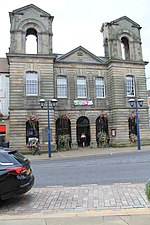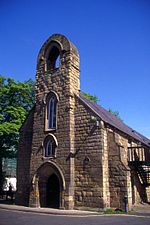Collingwood House, Morpeth
Country houses in NorthumberlandGrade II* listed buildings in NorthumberlandMorpeth, NorthumberlandNorthumberland building and structure stubsUse British English from August 2019

Collingwood House is a late 18th-century Georgian house, having Grade II* listed building status, at Oldgate, Morpeth, Northumberland. It was the home of Admiral Lord Collingwood from 1791 to his death at sea in 1810.The house is now used as the presbytery for the priest at the nearby Roman Catholic Church dedicated to St Robert of Newminster. The house hosts an annual celebration to commemorate Trafalgar Day on 21 October, particularly the role played by Admiral Lord Collingwood, whose ship helped break the Spanish line at the Battle of Trafalgar.
Excerpt from the Wikipedia article Collingwood House, Morpeth (License: CC BY-SA 3.0, Authors, Images).Collingwood House, Morpeth
Am Marktplatz, Verwaltungsgemeinschaft Bergtheim
Geographical coordinates (GPS) Address Nearby Places Show on map
Geographical coordinates (GPS)
| Latitude | Longitude |
|---|---|
| N 55.167706 ° | E -1.692792 ° |
Address
Sankt Bartholomäus
Am Marktplatz 6
97241 Verwaltungsgemeinschaft Bergtheim
Bayern, Deutschland
Open on Google Maps








